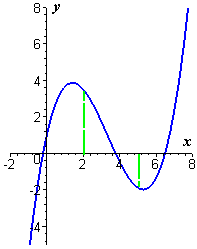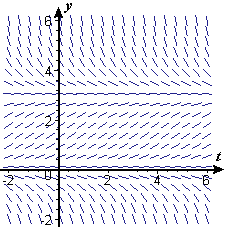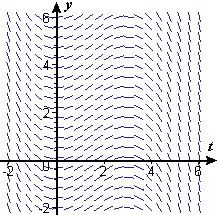Chapter 4
Differential Calculus and Its Uses
4.3 Solving Nonlinear Equations
by Linearization: Newton's Method
Problems
-
- Use Newton's Method to find all the zeros of the function in Example 2:
- Check your answers by calculating the value of `ftext[(]t text[)]` at each zero.
- Check your answers by zooming in on the graph.
- Check your answers by using the Solve or Root function of your graphing tool.
`ftext[(]t text[)]=t^4-18t^2-10t+39`.
-
- Use Newton's Method to find all three solutions of the equation `3x^2=e^x`.
- Check your answers by substituting into the original equation.
- Check your answers by zooming in on a relevant graph.
- Check your answers by using the Solve or Root function of your graphing tool.
-
- Use Newton's Method to find the root of `t^2-e^(-3t)=0`.
- Check your answers by substituting into the original equation.
- Check your answers by zooming in on a relevant graph.
- Check your answers by using the Solve or Root function of your graphing tool.
- Let `ftext[(]t text[)]=t^3+8t^2+t-6`.
- Calculate the values of `f` at `t=-10`, `t=-5`, `t=0`, and `t=2`.
- Why do your calculations in part (a) show that `f` has at least three zeros?
- How do you know that `f` does not have more than three zeros?
- Use Newton's Method to find all zeros of `f`.
- Check your answers. (Refer to Problems 1-3 for some ways to check.)
- Let `ftext[(]t text[)]=e^t+e^(-t)-2t^2.
- Find the four zeros of `f`.
- Find the three zeros of `f'`.
- Find the smallest value of `f` and the two values of `t` where `f` has its smallest value.
- Find the largest value of `f` between `t=-1` and `t=1`.
- Use the information from parts (a) through (d) to sketch the graph of `f`. Use your graphing tool to check your work.
- Use Newton's Method to find (approximately) all solutions of each of the following equations. Check your answers by using the Solve or Root function on your calculator or computer.
a. `x^3+5x=10` b. `x^3+5x=e^x` c. `x^3+5x=-e^x` d. `x^3-5x=10` e. `x^3-5x=e^x` f. `x^3-5x=-e^x` - Let `ftext[(]t text[)]=t^4-10t^2+e^(2t)`.
- Find all the zeros of `ftext[(]t text[)]`. (There are four.)
- Find all the zeros of `f'text[(]t text[)]`. [There are three — how must they be related to the zeros of `ftext[(]t text[)]`?]
- Find all the zeros of `f''text[(]t text[)]`. [There are two — how must they be related to the zeros of `f'text[(]t text[)]`?]
- Sketch the graphs of `ftext[(]t text[)]`, `f'text[(]t text[)]`, and `f''text[(]t text[)]`. (Use your graphing tool to check.)
- Find all local maximum points and all local minimum points of the graph of `f`.
- Find all inflection points of the graph of `f`.
- If Newton's Method is applied to `ftext[(]x text[)]=3x+4`, and `x_0` is `15`, what will `x_17` be?
- Find at least one solution to the equation `4x^3-x^4=30`, or explain why no such solution exists.
- Figure P2 shows a slope field for `dy text[/] dt=0.3ytext[(]3-y text[)]` for `t` ranging from `-2` to `6` and `y` also ranging from `-2` to `6`. Figure P3 shows a slope field for `dy text[/] dt=0.3t text[(]3-t text[)]` with both `t` and `y` ranging from `-2` to `6`. Click on either figure to get a printable page that shows both. You can use the printed page for drawing on the slope fields.
- On Figure P2 sketch the solution of `dy text[/] dt=0.3ytext[(]3-y text[)]` for which `ytext[(]0text[)]=0.5`.
- On Figure P3 sketch the solution of `dy text[/] dt=0.3t text[(]3-t text[)]` for which `ytext[(]0text[)]=0.5`.
- Solve the initial value problem: `dy text[/] dt=0.3text[(]3t-t^2 text[)]` with `ytext[(]0text[)]=0.5`.
- Your graph in part (b) should show that the solution in part (c) has a root near `t=5`. Take that as a starting guess, and find the next approximation to the root from Newton's Method.
Figure P2 `dy/dt=0.3ytext[(]3-y text[)]`Figure P3 `dy/dt=0.3 text[(]3-t text[)]` - The square root of a number `A` can be calculated by solving the equation `x^2-A=0` numerically.
- Show that application of Newton's Method to this equation leads to a simple repeated averaging scheme. What is being averaged at each step?
- Start with `x_0=1`, and compute `sqrt(7)` by this scheme. Compare your result with that obtained from the square root function on your calculator or computer. Could your computing tool actually be doing repeated averaging?
Note: This method for calculating square roots is sometimes called, on shaky evidence, the Babylonian method. See also Fowler and Robson, Historia Mathematica 25 (1998), 366-378.




